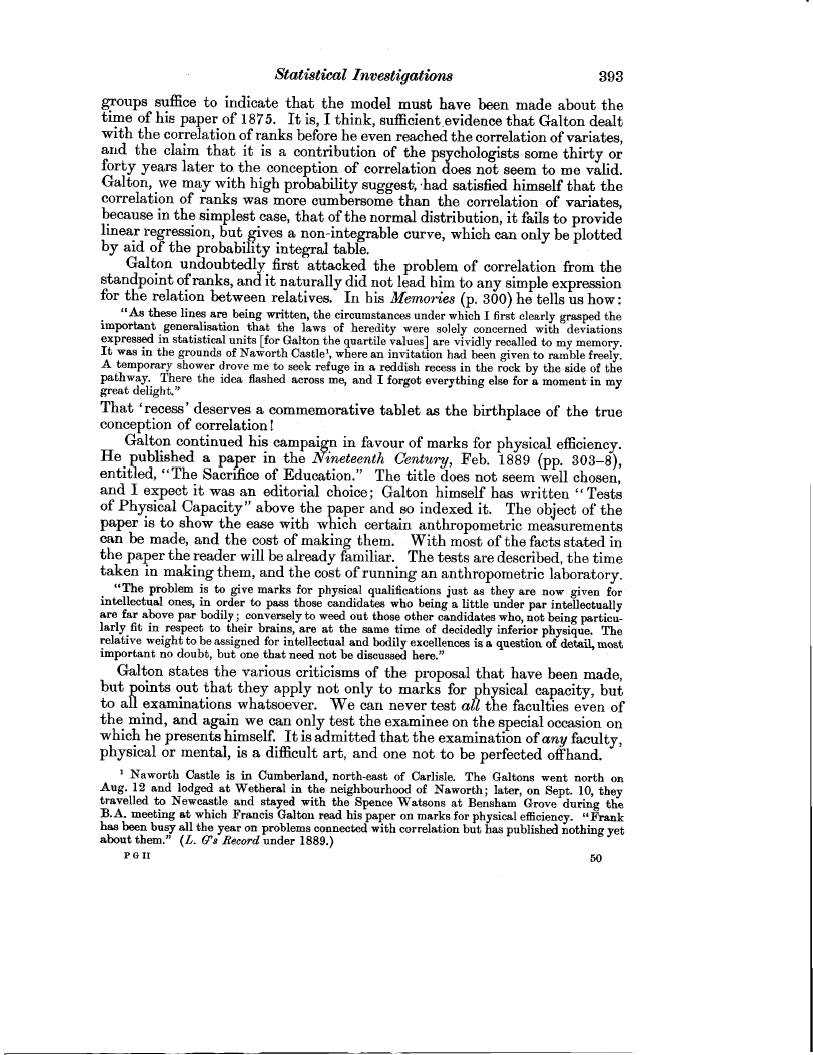Statistical Investigations 393
groups suffice to indicate that the model must have been made about the time of his paper of 1875. It is, I think, sufficient evidence that Galton dealt with the correlation of ranks before he even reached the correlation of variates, and the claim that it is a contribution of the psychologists some thirty or forty years later to. the conception of correlation does not seem to me valid. Galton, we may with high probability suggest, -had satisfied himself that the correlation of ranks was more cumbersome than the correlation of variates, because in the simplest case, that of the normal distribution, it fails to provide linear regression, but gives a non-integrable curve, which can only be plotted by aid of the probability integral table.
Galton undoubtedly first attacked the problem of correlation from the standpoint of ranks, and it naturally did not lead him to any simple expression for the relation between relatives. In his Memories (p. 300) he tells us how
"As these lines are being written, the circumstances under which I first clearly grasped the important generalisation that the laws of heredity were solely concerned with deviations expressed in statistical units [for Galton the quartile values] are vividly recalled to my memory. It was in the grounds of Naworth Castle', where an invitation had been given to ramble freely. A temporary shower drove me to seek refuge in a reddish recess in the rock by the side of the pathway. There the idea flashed across me, and I forgot everything else for a moment- in my
great delight."
That `recess' deserves a commemorative tablet as the birthplace of the true conception of correlation
Galton continued his campaign in favour of marks for physical efficiency. He published a paper in the Nineteenth Century, Feb. 1889 (pp. 303-8), entitled, "The Sacrifice of Education." The title does not seem well chosen, and I expect it was an editorial choice; Galton himself has written " Tests of Physical Capacity" above the paper and so indexed it. The object of the paper is to show the ease with which certain anthropometric measurements can be made, and the cost of making them. With most of the facts stated in the paper the reader will be already familiar. The tests are described, the time taken in making them, and the cost of running an anthropometric laboratory.
"The problem is to give marks for physical qualifications just as they are now given for intellectual ones, in order to pass those candidates who being a little under par intellectually are far above par bodily; conversely to weed out those other candidates who, not being particularly fit in respect to their brains, are at the same time of decidedly inferior physique. The relative weight to be assigned for intellectual and bodily excellences is a question of detail, most
important no doubt, but one that need not be discussed here."
Galton states the various criticisms of the proposal that have been made, but points out that they apply not only to marks for physical capacity, but to all examinations whatsoever. We can never test all the faculties even of the mind, and again we can only test the examinee on the special occasion on which he presents himself. It is admitted that the examination of any faculty, physical or mental, is a difficult art, and one not to be perfected offhand.
' Naworth Castle is in Cumberland, north-east of Carlisle. The Galtons went north on Aug. 12 and lodged at Wetheral in the neighbourhood of Naworth; later, on Sept. 10, they travelled to Newcastle and stayed with the Spence Watsons at Bensham Grove during the
B.A. meeting at which Francis Galton read his paper on marks for physical efficiency. "Frank has been busy all the year on problems connected with correlation but has published nothing yet about them." (L. 0's Record under 1889.)
roll 50

